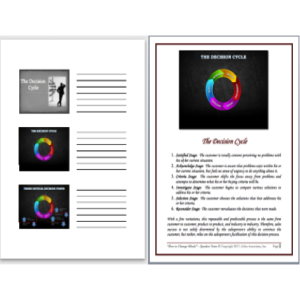 It seems like such a simple matter. You’ve been scheduled to deliver a short presentation, perhaps a keynote. As with every presentation you deliver, a lot is riding on this one. In your mind, you’ve prepared in every way imaginable. Your checklist looks something like this:
It seems like such a simple matter. You’ve been scheduled to deliver a short presentation, perhaps a keynote. As with every presentation you deliver, a lot is riding on this one. In your mind, you’ve prepared in every way imaginable. Your checklist looks something like this:
- Interview those involved to insure you understand presentation requirements.
- Include a nice blend of information, entertainment, and motivation.
- Create a strong blend of visual aids to support the presentation.
- Put in the time to practice and rehearse.
You cut no corners… or did you? Something rather simple has been left off that list. Leaving this off the list isn’t unusual; you’re in good company. For shorter deliveries, it is consistently left off the list by 99% of the professional speakers. What am I referring to? I’m talking about handouts. I’m talking about putting in the time to produce quality handout materials that support your presentation.
You know what? Maybe it doesn’t matter. After all, with your amazing energy and enthusiasm, how can something like a simple handout – that supports your presentation – be that important? Besides, it’s not as if you forgot to create a handout, you have one, sort of. You can give every participant a paper copy of each and every slide that goes up on the screen so the audience members can, well, look at them while you are speaking. Perhaps a few people will even save them for later. As a matter of fact, you’ve recently upgraded that handout, sort of. You now put three small pictures of your slides on each handout page along with a half dozen blank lines so the audience can try and figure out what you think is important and take notes while you are speaking. Isn’t that good enough?!
The answer is no. That’s not even close to good enough, unless you want to make a statement to your audience that you really don’t care about their focus or what information they retain. This is a blind spot for amateurs and pros alike. Suspend your disbelief for just a moment, and pretend this might be one of the most important presentations of your life. If it were, wouldn’t you create a handout that offered more? Participant guides are great for longer presentations, but what are you giving to the audience members of your shorter presentations? You need to have more than just small pictures of what an audience is already looking at. That’s why I recommend creating notes pages.
Notes pages are typically created with one slide per page, but the slide only covers about a third of the page. The other two thirds are covered with text in your own words, from the most critical points you intend to make while covering that slide within your presentation. You can create this using PowerPoint’s “notes pages” option when you pull down the “view” menu. You can also simply use a word document, copy your slides onto separate pages, and place text under them. Either way, if you put the time in, and create a handout that truly supports your presentation, you can now add a few things to your presentation checklist:
- Help the audience focus on me. You can open your presentation by telling your audience this: “I’ve taken the notes for you, so you can focus on me and not worry about missing the important points I’ll be making on each slide.”
- Help the audience learn. You’ll be helping them to separate the nice to know from the need to know, so your audience will be in a much better position to focus on the important points you’re trying to make after the presentation has been delivered.
- Help the audience reach me in the future. A good handout, with thoughtful content in it, is often retained, and so is the contact information found on the footer of the handout you are providing. You will also include a back page that can provide valuable information about you and your company.

Classic handout on the left, and a more thought-out handout on the right. Which would you prefer?
There is an irony to this; the one piece of the presentation puzzle that is so often missed is, in the end, the most permanent and lasting part of the presentation for the audience. It is definitely worth paying attention to this part of your presentation. It makes sense to add this to your preparation checklist… don’t you think?

Excellent tip Rob, always good to leave your audience w/ a “takeaway”. In this case you’ ve provided it for them.
You bet. The studies are not in our favor indicating what audiences truly retain from our spoken words. A handout with YOUR notes on them certainly helps if someone wants to go back and remind themselves what it is they learned. Thanks for the post Kent!
Yes. I’ve hired hundreds of presenters over the years, including many world-class speakers. I’ve always been surprised at the range of handouts they bring, and in some cases none. Great tips.
It makes a statement for sure. Having been one of those hundreds you hired over the years you know first hand I don’t mess around when it comes to handouts! Thanks for posting Fred.
I just sent a link to this article to the person I handed off a major client to when I semi-retired. It’s a Fortune 15 corporation where he now does what I did for years: prepare high-potentials for management careers, focused entirely on their communication skills. Great stuff–I hope he’ll choose to take your suggestion.
I do too. Just remember, if that work he’s performing involves a longer delivery he’ll be wanting to wow them with a professional looking participant guide rather than a keynote handout. Feel free to contact me directly if you’d like to see a template for that type of handout material. Thanks so much for posting Nancy.
As always, your words ring true, Rob! You’re right that few presenters do this, and this type of handout really does help the audience focus on YOU and your words. When I get this type of handout (it’s rare, but it does happen), I can easily just take a few extra notes instead of insanely trying to capture every gold nugget given by the speaker.